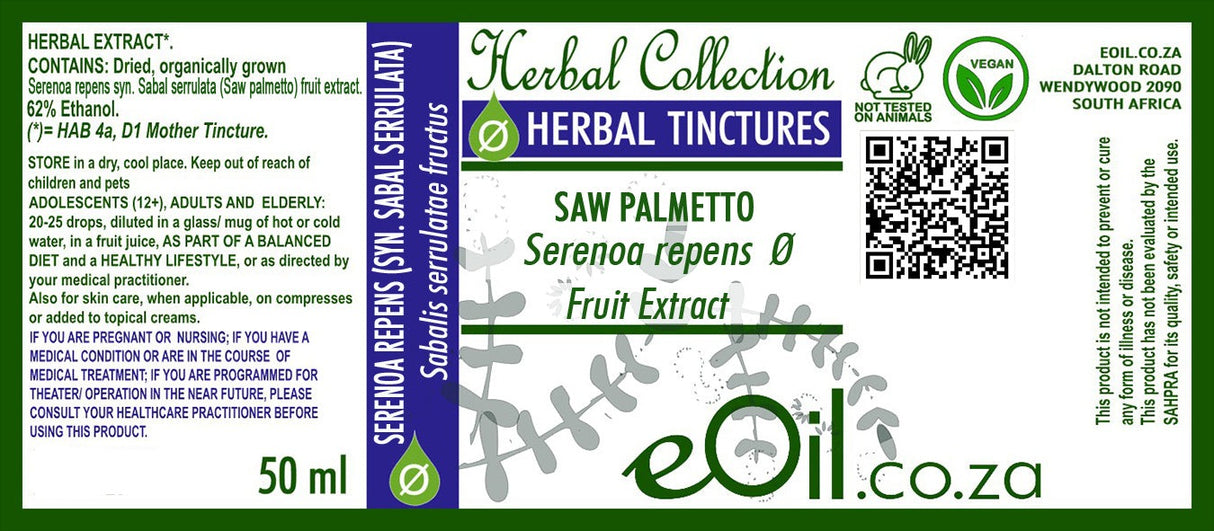Saw Palmetto Liquid Herbal Extract
Saw Palmetto Liquid Herbal Extract - 50 ML is backordered and will ship as soon as it is back in stock.
Description
Description
Understanding Mother Tinctures & Glycerines
Saw Palmetto Liquid Herbal Extract Tincture (Serenoa repens) is a pure, plant-based supplement traditionally valued for supporting prostate health, urinary tract wellness, hormone balance, and hair vitality.
Rich in active fatty acids and phytosterols, this vegan extract is additive-free and ideal for daily wellness routines focused on men’s health and natural balance.
TRADITIONALLY USED FOR
Saw Palmetto (Serenoa repens) Liquid Herbal Extract Tincture
Men’s herbal support for prostate, hair, hormones, and urinary wellness—potent, plant-based, and fast-acting.
Key Benefits
- Prostate & Urinary Health: Saw palmetto is best known for easing symptoms of benign prostatic hyperplasia (BPH), including frequent or difficult urination and nighttime trips to the bathroom.
- Hormone & Hair Support: Naturally helps to balance DHT (dihydrotestosterone) levels—may reduce male-pattern hair loss and support healthy hormone ratios in both men and women.
- Energy, Libido & Vitality: Used traditionally for mild libido and energy boosts, as part of holistic male vitality and wellness protocols.
- Anti-Inflammatory & Antioxidant: Rich in fatty acids and phytosterols, saw palmetto soothes inflammation and supports cell protection and whole-body immune health.
- Superior Absorption: Liquid tincture form ensures fast uptake, easy custom dosing, and mix-in convenience compared to capsules or tea.
Dosage & Directions
- Adults: 1–2 ml (20–40 drops) in a small amount of water/juice, once or twice daily as needed.
- For long-term use, seek guidance from your healthcare professional—review every 2–3 months.
- Women: May be suitable for androgen-related concerns (e.g., PCOS, hair loss), but only under health practitioner advice.
- Not for children or pregnancy/breastfeeding.
Cautions & Contraindications
- Rare side effects: mild stomach upset, headache, or dizziness.
- Not for pregnancy, breastfeeding, or children.
- May interact with hormone therapy, anticoagulants, or birth control—consult your doctor if on chronic meds.
- Stop if rash, allergy, or persistent adverse effects occur.
Storage
- Store tightly sealed, below 25°C, and away from direct sunlight; keep out of children’s reach.
Saw Palmetto Tincture Recap Table
| Product Type | Main Benefits | Dosage & Use | Best For | Not For / Cautions |
|---|---|---|---|---|
| Tincture | Prostate, urinary, hair, hormone, libido, anti-inflammatory | 1–2 ml (20–40 drops), 1–2x daily | BPH, men’s wellness, hair, hormones | Pregnancy, children, medication cautions |
Buy saw palmetto tincture South Africa, Serenoa repens prostate support, vegan men’s health drops, natural hair loss remedy, urinary wellness tincture, hormonal balance herbal, liquid herbal extract BPH remedy.
INFORMATION
Saw Palmetto (Serenoa repens) Tincture
Identification
Common Name: Saw Palmetto
Latin Name: Serenoa repens
Family: Arecaceae
INCI Name: SERENOA SERRULATA FRUIT EXTRACT
CAS Number: 84604-15-9
EINECS/ELINCS No: 283-292-7
Description
Saw palmetto tincture is a liquid extract made from the berries of the Serenoa repens palm, native to the southeastern United States.
The tincture contains a concentrated form of the plant's active compounds, including fatty acids and phytosterols.
Traditional Uses
Saw palmetto has been traditionally used to support:
- Prostate health
- Urinary function
- Hair growth
- Hormonal balance
- Reproductive health
Modern Research
Recent studies suggest saw palmetto may help with:
- Benign prostatic hyperplasia (BPH) symptoms
- Male pattern baldness
- Reducing inflammation
- Supporting urinary tract function
However, more research is needed to fully confirm these effects.
How to Use
Dosage: Typical dosage is 1-2 ml of tincture, taken 2-3 times daily. Follow product label instructions or consult an herbalist.
Administration: Take tincture diluted in water or juice. May be taken with or without food.
Duration: Can be used long-term. Consult a healthcare provider for personalized guidance.
Cautions & Side Effects
- Generally well-tolerated when used as directed
- May cause mild digestive upset in some individuals
- Avoid use during pregnancy and breastfeeding
- May interact with certain medications, including blood thinners and hormonal treatments
- Discontinue use 2 weeks before surgery
- Not recommended for children under 18
Quality
Look for organic, ethically wildcrafted tinctures made from ripe saw palmetto berries. Choose products standardized to contain 85-95% fatty acids and sterols. Store in a cool, dark place.
Sustainability
Wild saw palmetto populations are threatened by overharvesting. Choose products made with sustainably harvested or cultivated saw palmetto to support conservation efforts.
References
- Tacklind J, et al. Serenoa repens for benign prostatic hyperplasia. Cochrane Database Syst Rev. 2012;12:CD001423.
- Evron E, et al. Natural hair supplement: Friend or foe? Saw palmetto, a systematic review in alopecia. Skin Appendage Disord. 2020;6(6):329-337.
- Sirab N, et al. Antiinflammatory properties of lipidosterolic extract of Serenoa repens (Permixon®) in a mouse model of prostate hyperplasia. Prostate. 2013;73(12):1391-1398.
- Saw palmetto. National Center for Complementary and Integrative Health. Accessed September 22, 2024.
Disclaimer: This information is for educational purposes only and is not intended to diagnose, treat, cure, or prevent any disease. Consult a qualified healthcare practitioner before using herbal products, especially if you are pregnant, nursing, or taking medications.
CAUTION
Store in a cool, dry place, away from light. Keep tightly closed, away from the reach of Children and pets.
Do not exceed the daily dose.
This product is not intended to prevent or cure any form of illness or disease.
If you are pregnant or nursing ; If you have a medical condition or are in the course of medical treatment ; If you are programmed for theater/operation in the near future, please consult your healthcare practitioner before using this product.
This product cannot replace a varied and balanced diet and a healthy lifestyle.
This product has not been evaluated by the SAHPRA for its quality, safety or intended use.

Saw Palmetto Liquid Herbal Extract - 50 ML is backordered and will ship as soon as it is back in stock.





